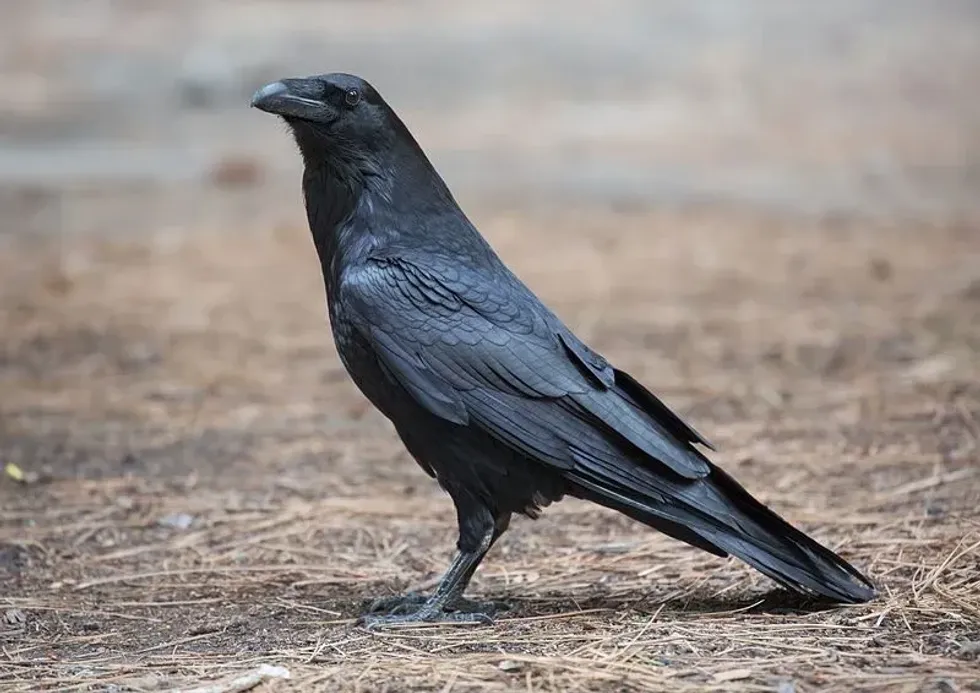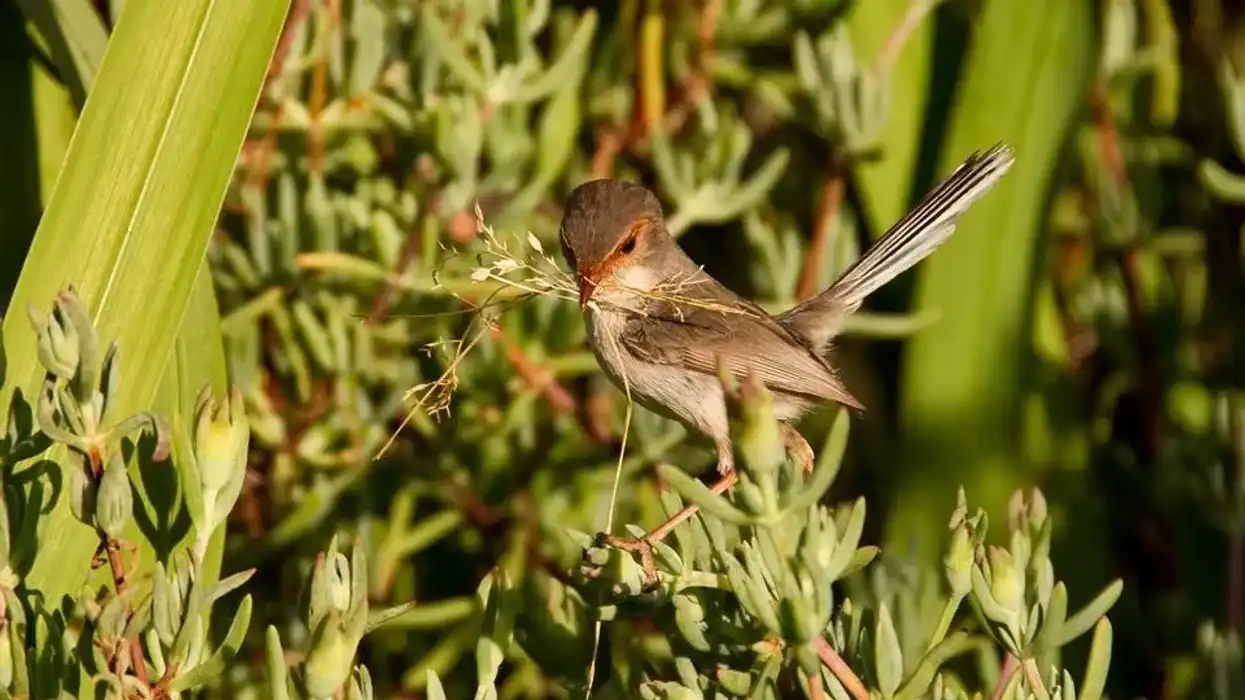The common raven is a member of the Corvidae family. The common raven scientific name is Corvus corax.
The common raven range is throughout the Holarctic, the temperate habitats in North America and Eurasia, down through to the North African deserts, and also in the islands in the Pacific Ocean. The common raven habitat includes deciduous and evergreen forests up to the treeline, as well as high desert, sea coast, sagebrush, tundra, and grasslands.
These birds roost on power lines too. This common raven bird is large in size and has black plumage and the common raven tail is wedge tail shape and has robust bills.
The common raven call is quite loud and vocal and there exists a wide variety of common raven sounds and calls. The common raven diet includes animal foods like arthropods, amphibians, small mammals, birds, reptiles, and carrion and they get their food sources from the ground.
Their food also includes seeds and grains.
It is also known as a predator of desert tortoises. The common raven wingspan ranges from around 39-59 in (1000-1500 mm).
Their predators include hawks and owls. The status of these birds' conservation is Least Concern.
A common raven pet is difficult to manage, though smart and intelligent, it is illegal to own it without a permit in the United States. It is quite fascinating to learn about these ravens or Corvus corax, as it is known scientifically and if you're interested, read about the carrion crow and Hawaiian crow too.
Common Raven Interesting Facts
What type of animal is a common raven?
The Ravens are birds.
What class of animal does a common raven belong to?
The ravens belong to the class of Aves of birds.
How many common ravens are there in the world?
A 2011 estimation states that there are around 8.7 million birds but the number changes each year.
Where does a common raven live?
These ravens live in open forests. They range throughout the Holarctic from the Arctic and temperate habitats in North and Central America and Eurasia to the deserts of North Africa and to the islands in the Pacific like the Canary Islands.
What is a common raven's habitat?
These ravens live in open and forest habitats. This includes evergreen and deciduous forests up to the treeline, as well as high desert, cliff ledges, grasslands, sagebrush, tundra, and sea coast.
Who do common ravens live with?
These ravens travel in mated pairs and the young ravens can be seen forming flocks sometimes.
How long does a common raven live?
Common ravens are known to live for about 10-15 years in the wild.
How do they reproduce?
Displays happen throughout the year but it becomes intense during fall and winter. It is believed that these pairs stay together for the year, but some believe that the mating occurs for life, however, there is no concrete evidence.
Females tend to invite copulation by asserting certain positions. Breeding and egg-laying happen between mid-February and May.
Three to seven eggs are laid usually and incubation takes place for about 20-25 days. Not much information is available about the nest sites but nests are made with sticks mostly and are in a shape of a cup. The young or the juvenile ravens leave the nest after five to seven weeks of age.
They are sometimes known to leave the area or their families within weeks, while some choose to live with their families for an extended period of time. The young attain sexual maturity at about three years of age.
What is their conservation status?
The status of the ravens is Least Concern.
Common Raven Fun Facts
What do common ravens look like?
Common ravens are large in size and black in color. These ravens have a wedge-shaped tail. These birds have a well-developed ruff of feathers on the throat which is often used during social communication. This ruff of throat feathers is also known as hackles and is brownish-gray in color.
The iris is dark brown in color. It has a robust bill. The juveniles are similar but have duller plumage with a blue-gray iris.
How cute are they?
Some people consider this bird species cute because of its black plumage, however, many think of it as unlucky and a scavenger bird.
How do they communicate?
This species of bird is quite vocal and uses a variety of calls and non-vocal sounds for various purposes. There are alarm calls, chase calls, comfort sounds, and calls for advertising territories. Non-vocal sounds consist of bill snapping and wing whistles.
These birds are also known to communicate by physical displays of threat or appeasement to subordinate or dominant ravens. Pairs may chase intruders and engage in aerial fights. Tactile cues are used such as allopreening.
How big is a common raven?
The common raven size is considered large and is comparatively bigger than crows and the weight is around 1.5-4.4 lb (0.69-2 kg). The length of the species ranges from 22-30.7 in (560-780 mm).
How fast can a common raven fly?
The average speed of ravens is known to be up to 25 mph (40.2 kph) but it is believed that trained ravens can reach a speed of around 48 mph (77.2 kph).
How much does a common raven weigh?
The weight of these raven species ranges from 1.5-4.4 lb (0.69-2 kg).
What are their male and female names of the species?
There are no specific names for the males and females of the species.
What would you call a baby common raven?
There is no particular name for a baby of this bird species.
What do they eat?
Common ravens are primarily scavengers. They feed on a variety of animals like arthropods, amphibians, small mammals, birds, reptiles, and carrion. They also eat insects like maggots and beetles. Vegetable foods include grains, acorns, fruits, and buds. They take their food from the ground and store foods of all kinds.
Are they dangerous?
These birds are quite vigorous when defending their babies and they attack predators or the potential ones by flying and lunging at them with their large bills. Humans get attacked if they come near to the nests. Serious injuries are unlikely.
Would they make a good pet?
This bird does not make a great pet. This bird cannot be kept as a personal pet without prior training and a permit.
If you do not have a permit the bird could be confiscated and you could be fined. If you want to keep this bird as a pet, it is better to get one when it is a baby. These birds are smart and intelligent and it is difficult to care for these birds.
Did you know...
The common raven intelligence rates up with animals like chimpanzees and dolphins. It has been observed that if this bird knows that another bird is watching it hide its food, it would pretend to hide it in one place while actually hiding it in another place but as all the ravens are smart, it only works sometimes.
In captivity, these birds can mimic humans better than parrots. They can also imitate other noises like car engines and toilet flushing.
In the past, these birds were considered to be evil in disguise in some European cultures. In France, it was believed that these birds are the souls of the wicked priests.
In Germany, it was believed that this bird was the incarnation of satan or the damned souls. In Sweden, this bird, if croaking, was thought of murdered people who did not have proper Christian burial.
In certain cultures ranging from Tibet to Greece, this bird was known to be a messenger of gods.
Ravens have been observed using snow-covered roofs as slides and it is believed that these ravens love to play.
Ravens are known to lie in anthills and roll on ants to swarm on them and also chew them and rub their guts on their feathers. This process is known as anting and some other birds like crows and jays also engage in this process. The reason behind this behavior is not properly known.
These birds use some non-vocal sophisticated gestures which have not been naturally observed in other animals other than primates.
These ravens are known to be adaptable to different environments. They can live in various habitats and environments from a mountain, forests to snow and desert.
These ravens are not common in California and it is believed that crows and ravens cannot be spotted in the same places.
In many incidences, it has been observed that ravens are interested in snatching white golf balls and do not snatch other colored ones.
It has been observed and recorded that these birds nests around garbage dumps and a lot of their diet includes eating food waste.
It has been observed that ravens are known to be empathetic and console the losing bird in a fight and are also known to hold grudges.
The common raven predators include coyotes, large hawks, eagles, and owls.
Wingbeats of these ravens are considered to be faster and steadier than the crows.
Ravens can kill a chicken but it has been observed that these ravens go for the easier targets.
Common ravens are the largest passerines.
How does the common raven learn?
These birds are quite intelligent and smart and have the capability to communicate a wide range of messages through their calls. It is also believed that they mimic better than parrots.
Where is it legal to own a common raven?
It is illegal to own this bird in the United States without a permit. Imported common ravens can be kept in Europe, Africa, and Asia as a pet as long as they do not migrate to a United States-based area.
Here at Kidadl, we have carefully created lots of interesting family-friendly animal facts for everyone to discover! Learn more about some other birds including the house wren, or swan.
You can even occupy yourself at home by drawing one on our Common Raven coloring pages.










